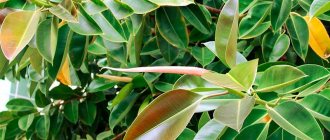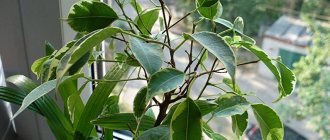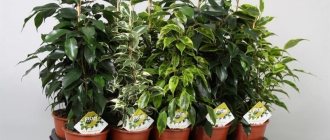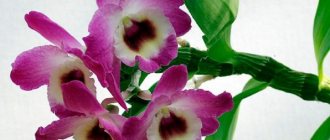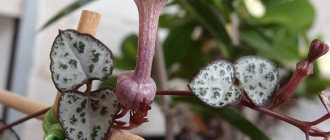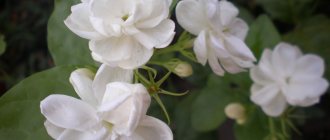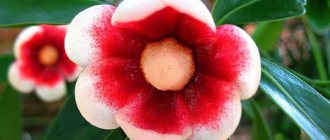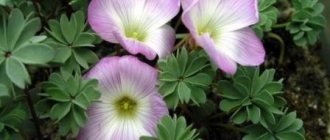By providing your ficus with proper care, you will grow a resilient, durable plant that can live for as long as fifty years!
Appearance
Ficus elastica Melany belongs to the species Ficus rubbery. The variety was bred not so long ago and quickly gained popularity among lovers of indoor flowers, thanks to its exotic appearance and compactness.
The homeland of rubber-bearing ficuses is tropical Asia. In the wild, they are huge trees, up to 40 m high, with unusual aerial roots. Melanie is the most compact representative of her species, which appeared thanks to selection.
Rubber-bearing ficuses, including Melanie, are supplied to our market from Holland, which specializes in breeding new varieties. Plants of various colors and sizes (from a couple of centimeters to two meters) are available for sale.
The description of its origin is not entirely usual. In one of the Dutch greenhouses, an interesting plant was discovered that independently mutated from the ficus elastica variety Decor. They took cuttings from it, rooted them and propagated them. The result was a stable hybrid that fully retained the characteristics of the mother bush. This made it possible to distinguish it into a new bush variety, which was given the poetic female name Melanie.
In a pot on the windowsill, Melanie grows on average up to 40-50 cm. The main feature of the variety’s structure is that it grows not in the form of a tree in height, but laterally in the form of a lush but neat bush. This makes it possible to experiment with the shape of its crown while maintaining its small size. Thanks to its dense leaves and woody trunk, Ficus Melanie, even with its very small size, looks like a fully formed adult plant.
At the beginning of its growth, Ficus Melanie looks like an unbranched plant with a woody trunk, but over time it begins to branch.
If we talk about flowering, ficus Melanie does not bloom in indoor conditions. Moreover, its leaves look so impressive that the absence of flowering does not at all affect its decorative characteristics.
Melanie's leaves have an oblong-oval shape with pointed tips curved towards the bottom. They look very impressive: up to 15-20 cm in length and 5-6 cm in width, dense, leathery, with a glossy surface. Mature leaves are dark green with light veins on the front surface and olive with red veins on the back side. Young leaves have a reddish-burgundy tint. This play of color on one plant gives it additional decorative value.
This variety also has a variegated variety - Ficus Elastica Melany variegata. The main difference is in the color of the leaves; it is the same, but with white inclusions and an uneven white border around the edges. In other respects (shape, size, cultivation characteristics), the variegated rubber ficus Melanie is no different from its counterpart.
Inexperienced gardeners often compare ficuses Melanie and Benjamin. This is quite difficult to do, since even in appearance they differ very much. In addition, Ficus Benjamina is not a rubber plant.
Trimming
Ficus Melanie is pruned in order to stimulate the growth of certain parts of the flower. The procedure is usually performed in February or March. If you want the plant to grow to the side, then you will need to cut off the top. By cutting off 5-6 top buds, you can achieve the shape of a beautiful and branchy bush.
Some gardeners tilt the ficus to the ground and fix it in this position for a while. During this period, the lateral buds begin to become active, producing new branches and leaves.
Features of care
If you decide to grow “your own” rubber ficus Melanie, caring for this plant at home will not be burdensome for you. Even flower growers with no serious experience do not experience problems with its maintenance. When purchasing a “ready-made” green pet in a store, pay attention to the following points:
- Choose young specimens. With age, the rubber ficus adapts less well to a new place, and an adult tree may not take root with you.
- The best time to buy is spring and early summer. This is the period of active growing season, when it is easiest for the plant to adapt to new conditions.
- Examine the leaves carefully. In healthy specimens, they should look fresh, healthy, without any blemishes.
- Lightly shake the stem and move your palm against the growth of the leaves. If they fall off, the ficus is unhealthy and there is no need to take it.
The milky sap of ficus trees has a strong irritant effect and even with a single contact can cause acute dermatitis or severe allergies. Therefore, all agrotechnical work with ficus should be carried out with gloves.
Watering
For ficus Melanie, infrequent watering is better than excessive watering. There is no special watering schedule. You need to focus on the condition of the soil in the pot: the soil should be dry, but not overdried or cracked. That is, watering must be carried out when the top layer of the earthen clod has dried to a depth of 4-5 cm. On average, based on these indicators, summer watering is carried out approximately 2 times every 7-10 days, in winter for the same period of time 1 times.
Do not flood the soil. Ficus plants do not tolerate stagnant moisture, so when replanting it is necessary to provide a sufficient layer of drainage. In hot months, water is poured into the pot until it comes out on the tray. During the cold season, Melanie is watered more moderately. The glossy surface of the leaves needs to be periodically wiped with a dry soft cloth to remove dust and water stains.
Air temperature and humidity
Melanie tolerates air temperatures from +18 to +30 °C well; she dies if the air in the apartment drops to + 12 °C, and the ideal temperature range for it is +20-25 °C.
If the temperature in the apartment is above average or the air is too dry (on hot days or during the heating season), the crown is sprayed from time to time. To do this, use water at room temperature that has been standing for about 10 hours.
Lighting
As mentioned above, caring for ficus elastica is not difficult, but some nuances must still be observed. The variety does not tolerate direct sunlight, so its lighting should be diffused. Melanie feels best on western or eastern windows. In winter, it may require additional lighting using phytolamps.
To form a beautiful symmetrical crown, the pot must be periodically turned to the light source in different directions. If there is insufficient lighting, Melanie's leaves may fall off, and if there is too much light, burns may appear on them.
The soil
Experienced gardeners recommend purchasing ready-made specialized soil for ficus plants. If this is not possible, focus on the following indicators; the soil should be:
- neutral or slightly acidic;
- moisture permeable;
- breathable.
When preparing the mixture yourself, take and mix:
- 1 part sheet soil;
- 1 part turf;
- 1 part humus;
- half of the sand.
Special requirements are imposed on drainage, which is used as:
- expanded clay;
- wood or coarse sand;
- crushed stone
Expanded clay is most preferable, since this material tends to absorb excess moisture. A drainage layer is laid out up to 1/3 of the pot.
You can use universal soils from the store, but most often they are made from the cheapest material: peat, filled with mineral fertilizers. They have little humus and a lot of fiber. Therefore, it is better to make the soil for the ficus yourself.
Feeding
During the period of active growth, young ficus is fed 2 times a week. It is best to use natural compounds as fertilizers, for example, nettle infusion, wood ash or liquid mineral mixtures. They need to be added to moist soil - on the day of watering or the next day after.
Subsequently, fertilizing is carried out 2-3 times a year: 1 time in the cold season (autumn - winter) and, accordingly, 1-2 times in the warm season (spring - summer).
It is not recommended to feed the ficus during the first month after planting. At this time, its root system is in the adaptation stage, and the substances included in the fertilizer can dry it out.
Transfer
Ficuses grow very quickly, so for the first 5 years of their life they need to be replanted regularly, focusing on the previous replanting date, which is ideally repeated once a year. A new pot is chosen that is 2-3 cm larger in diameter than the previous one. The best time to “move” is spring, when the ficus is actively forming new shoots and it will be easier for it to adapt to the new container.
In the future, replanting becomes a vital necessity when the roots completely fill the space of the pot or even peek out from the drainage holes. If this does not happen, specimens aged 5 years and older do not need to be replanted entirely, but only replace the top layer of soil about 3 cm deep, being careful not to touch the roots.
Trimming and pinching
The result largely depends on the season when pruning is carried out. As already mentioned, all important procedures should be carried out in the spring, preferably at the end of February - in March. It is during this period that the plant is most viable, and by removing excess shoots, you will stimulate it and help form a beautiful and lush crown.
Ficus Melanie grows quickly. If the necessary conditions are created, new leaves bloom every 7-10 days in spring and summer, making it easy to give the bush the desired shape. To do this, you need to pinch the top shoots into 4-6 leaves. If you harvest less, the bush will develop side shoots, but its height growth will not slow down.
Pinching and pruning in the autumn-winter period will lead to the fact that the ficus will develop one-sidedly. At this time, the plant lives off the energy and nutrients accumulated over the summer. By removing shoots, you will deprive it of these reserves.
Experienced flower growers know a trick that allows ficus plants to produce side shoots. You need to tilt it to the ground as much as possible and fix it in this position. Thanks to these manipulations, the top stops growing, and the side buds begin to wake up.
Soil and fertilizing
A porous and nutritious substrate is what the ficus needs so much. You can buy soil, or you can make it yourself.
For this you will need:
- peat (1 part);
- turf land (1 part);
- humus (1 part);
- river sand (1 part).
The components are mixed and at this point the production of the soil mixture can be considered a completed process.
At the time of active growth, the flower is fed twice a week. Natural compounds are used as fertilizers. These include wood ash or nettle infusion.
Reproduction of ficus Melanie
Like transplanting, it is better to propagate ficus in the spring, when the vegetative forces of the ficus are at their peak. Reproduction at home is practiced in two ways: cuttings from apical shoots and air layering. In the first case, a shoot about 15 cm long with 2-3 leaves is cut from the top with a sharp knife and placed in moistened soil or in a glass of water. For speedy rooting, it is recommended to wash off the milky juice from the cut and dip the cut area in the root solution.
The second method is more difficult and requires some experience. A transverse cut is made on the stem obliquely, 1/3 of the width. To prevent it from growing together, insert a match or toothpick inside. Then a piece of peat is placed on the notched area, wrapped with polyethylene on top and left in this form until small roots appear on the stem. After which the peat is removed, the shoot and roots are completely cut off and planted in the ground in a permanent place.
How to care
Ficus rubber is a plant that is undemanding. Subject to basic care requirements, it will allow you to grow a good indoor plant.
soil for ficus plants or any soil for indoor plants is suitable. Vermiculite/perlite must be added to it. Mix the soil well. Soil for ficus can be bought at garden centers, where you can also choose a pot for ficus. The pot is selected according to the size of the plant itself, or rather a little larger in diameter and depth.
- planting is carried out immediately after purchasing the plant, or during transplantation. You need to carefully remove the plant from the pot and replant it in a new one. Try to keep it at the same level as it grew before. Do not deepen the trunk and root collar too much. This can lead to rotting of the stem and roots.
-transplantation is carried out once in the spring season. It is enough to do a transplant at intervals of two years. Each time you replant, select a ficus pot that is larger in size than the previous one. If your plant is very large and mature, it is enough to replace part of the soil. Carefully remove the top part of the soil and add more fertile soil.
Diseases and pests
Despite its vitality and resilience, ficus Melanie, which is not properly cared for or sheds its leaves incorrectly, may become ill or be attacked by pests.
As for green pet diseases, their main symptoms are as follows:
- leaves turn yellow and fall off;
- brown spots appear on the leaves;
- general development slows down.
All these problems occur due to the same reasons:
- increased humidity or, conversely, dry soil;
- lack of light;
- location in a draft;
- sudden temperature fluctuations in the room.
In addition, the leaves of the plant often turn yellow due to root rot, which can also be caused by waterlogging or excessive fertilizing. And brown spots can be the result of sunburn if the ficus pot is exposed to the direct rays of the scorching sun for a long time.
Pests that threaten the successful development of Melanie are typical for most indoor green pets:
- Spider mite. A white coating, or rather a cobweb, appears on the leaves and between the leaves. Its main cause is dry air, so prevention consists of periodically spraying the crown with settled water at room temperature, and treatment involves spraying with special biological products.
- Greenhouse thrips. Small insects with an elongated body up to 2 mm long, dark brown, black or light yellow, literally dotting the leaf plates. The fight consists of thoroughly washing the stem and leaves with warm water, spraying with biological products, treating the pot and completely replacing the earthen clod.
- Shield. A characteristic feature of this pest is a protective covering that resembles a turtle shell. Scale insects adhere their bodies tightly to the lower surface of the leaves and stems, as if they are growing into them. Areas damaged by scale insects are destroyed, healthy parts are treated with a solution of laundry soap or special preparations.
Folk signs and superstitions
If you believe folk superstitions, which can be found in the public domain, the plant has many properties:
- Ficus Melanie can effectively overcome fatigue during work if you place a pot with a plant near your desktop.
- If you place it in the hallway, you can use the flower to attract guests.
- The plant can restore the harmony of intimate relationships if you place a pot of Melanie in the bedroom.
At the same time, it is not advisable to place a tree in the center of the room.
5 / 5 ( 1 voice )
Beneficial features
Ficus Melanie is not only one of the interior decorations. It also has practical benefits. Its leaves are capable of absorbing vapors of phenol, benzene and trichlorethylene, which are emitted by plastic household items and furniture made from non-natural materials, thereby improving the health of the air in the apartment.
The leaves of rubber-bearing ficus trees are also used in folk medicine. For example, they apply it to boils at night so that pus comes out of them. Juice from Melanie leaves helps with hemorrhoids, some diseases of the female reproductive system, has an antiseptic effect and promotes wound healing.
It is believed that ficus should be purchased exclusively during the waxing moon, and be sure to give the donor something in return. A ficus received free of charge will bring trouble to the new owner. So thank the one who gives it to you, at least symbolically.
Many folk signs and superstitions are also associated with ficus trees. For example, it is widely believed that the presence of a ficus in the house promotes conception, so it is often recommended for couples suffering from infertility. Also, according to popular belief, ficus has powerful energy that protects the house from evil forces. Naturally, there is no scientific basis for these signs, but it is undeniable that the very process of caring for a green pet gives positive, healthy emotions.
Ficus Melanie does not take up much space and looks harmonious in both residential and office spaces. This spectacular exotic plant reproduces easily, quickly forms a lush crown, serves not only to decorate the interior, but also to clean the air from harmful fumes and is completely unpretentious. By spending a minimum amount of labor and time caring for it, you will receive maximum benefits and positive emotions.
Description and features of the Elastica Melanie variety
Ficus Melanie was bred by Dutch breeders. Characteristic features of the plant include:
- compactness;
- horizontal growth;
- infrequent flowering.
The florist can easily make the crown of the desired shape. Compactness makes it possible to place ficus on window sills or other small areas. It is noteworthy that it does not bloom in the apartment. This makes it an ideal plant for those who love greenery rather than flowers.

